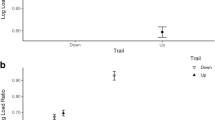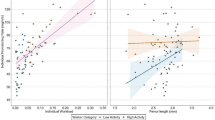Abstract
In the present study we investigated the economics of load transport in the grass-cutting ant Atta vollenweideri by focusing on the effects of load mass, width and length on individual transport rates. Both running speed of foragers and the amount of material transported a given distance per unit time, i.e. gross material transport rate, were evaluated in both field and laboratory colonies. In order to separate the effects of load mass, load length and width on transport rate, workers were presented with paper fragments which differed twofold either in length, width or mass, but not in the other parameters. When controlling for fragment mass, both running speed of foragers and gross material transport rate were observed to be higher when they carried short fragments: A twofold increase in fragment length had a marked negative effect on manoeuvrability during transport and, as a consequence, on material transport rate. In contrast, if fragment mass was doubled and length maintained, running speed differed according to the mass of the loads, with heavier fragments being transported at the slower pace. For the sizes tested, heavy fragments yielded a higher transport rate in spite of the slower speed of transport, as they did not slow down foragers so much that it counterbalanced the positive effects of fragment mass on material transport rate. Doubling the width of the fragments without changing their mass had no influence on running speed and transport rate. When presented with a choice of dropped fragments differing in the size variables mentioned above, workers discriminated among fragments of different size and preferred shorter fragments, thus rejecting loads that are associated with higher travel times and lower material transport rates. It is argued that, based on the energetics of cutting, workers might maximize their individual harvesting rate by cutting long grass fragments, since the longer a grass fragment, the larger the amount of material harvested per unit cutting effort. Our results indicate, however, that larger loads negatively affect transport rates. The sizes of the fragments cut by grass-cutting ants under natural conditions may represent the outcome of an evolutionary trade-off between maximizing harvesting rate at the cutting site and minimizing the effects of fragment size on material transport rates.
Similar content being viewed by others
Author information
Authors and Affiliations
Corresponding author
Additional information
Electronic Publication
Rights and permissions
About this article
Cite this article
Röschard, J., Roces, F. The effect of load length, width and mass on transport rate in the grass-cutting ant Atta vollenweideri . Oecologia 131, 319–324 (2002). https://doi.org/10.1007/s00442-002-0882-z
Received:
Accepted:
Published:
Issue Date:
DOI: https://doi.org/10.1007/s00442-002-0882-z




